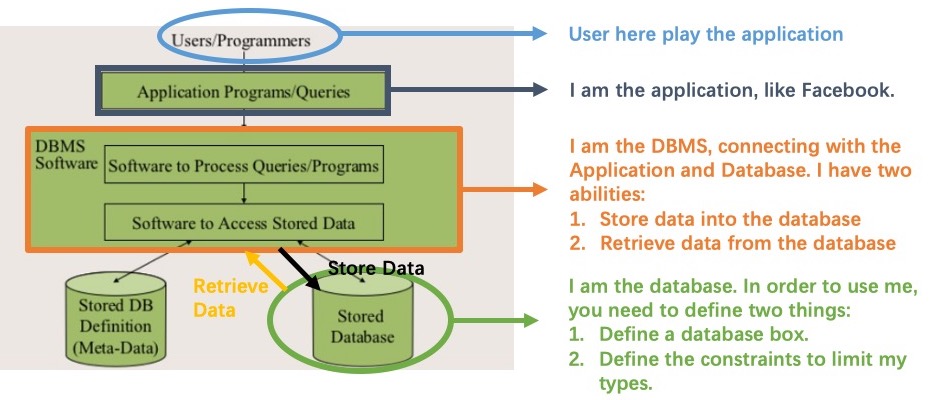Introduction:
When defining a term, we need to fully consider the needs and background of the audience and the goals we want to achieve. At the same time, we should also find whether the term to define has a global implication. If the term we want to explain is inconsistent with the general concept of the public, we have to express their differences clearly. Only in this way can more effective results be achieved when we are doing a definition.
Audience and Situation
A term I want to define is the ‘Database Management System(DBMS),’ which is often used in the process of program development. Sometimes programmers often use the term ‘Database’ instead of ‘Database Management System’ in the development process. The situation is to train the students with no database-related background to have a database related seminar. The goal is to give these people a better understanding of what is a database management system.
Parenthetical Definition
Database management system: a database managing software, referred to as DBMS.
Sentence Definition
Database management system: “software designed to assist in maintaining, utilizing extensive collections of data”(Ramakrishnan 4).
Expanded Definition
DBMS is a software designed to assist in maintaining, utilizing extensive collections of data. Another “alternative to using a DBMS is to enable users to create and store the data in files and write application code to manage it”(Ramakrishnan 4).
Negation
Database management system, although people call it ‘database’ for convenience, it actually cannot be called ‘database’ because they are fundamentally different. The database is a general concept to describe a collection of data. In contrast, the database management system is software that operates after having the idea of data collection, which is a tool.
Process of a database management system
The database operating system requires several steps to achieve.
First of all, “defining a database. It involves specifying the data types, constraints (Ramakrishnan 62). It requires the programmer to define the type of data, such as numeric or date type, so that when the user enters a wrong data type, the system does not allow data to log in or throw an error. It is also the usual time when users operate some software; if the type of input is wrong, they will not be able to register.
The second is constructing data and storing them into some storage medium that is controlled by DBMS. Typically, because of the capacity of data, it is generally stored on the hard disk of the computer.
Finally, the operation of the system, use the effective methods provided in the DBMS to query, update, delete data, and generate data tables. When the user sends a query request, the DBMS performs the query action before going to access the database, and returns the corresponding data of the user, as shown in Figure below.

Image credit to Batayola
Advantages of using a database management system
- Controlling redundancy. The control of data types and restrictions can control repeated single data. By maintaining a single repository of data that is defined once and is accessed by many users.
- Restricting Unauthorized Access. A database management system can provide a security subsystem to create and control different types of user accounts and restrict unauthorized access.
- Providing Backup and Recovery. Losing data is a disaster for a website or app. A database management system can back up data to prevent malicious attacks or loss.
What are the popular database management systems?
- Oracle, a muti-model database management system produced by Oracle Corporation. Now it is the top of lists of accessible databases, providing robust management of databases holding millions of records, which is “suitable for large companies looking for a database management system to have various features”(Arsenault).
- My SQL (Structure Query Language), the second most popular open-source database for web-based applications, focusing on speed and reliability rather than including a vast array of features. “It is now also the database management system used by Facebook, Twitter, and Youtube.”(Arsenault).
- Microsoft SQL Server, which is a database management system developed by Microsoft, is currently the third most popular. “It provides the functions of cloud server and local servers working at the same time, and can also be visualized on mobile devices”(Arsenault). It has excellent compatibility with other Microsoft products and is suitable for companies and institutions that use many Microsoft products.
Works Cited
Ramakrishnan, Raghu, and Johannes Gehrke. Database Management Systems. McGraw-Hill, Boston, 2003, pp 4
Arsenault, Cody, “The Pros and Cons of 8 Popular Databases” Keycdn.com KeyCDN,20 Arpil2017, https://www.keycdn.com/blog/popular-databases Accessed 4 June 2020.
Batayola ,Winona Amanda,“354 ch1“ [Image] slideshare.net Nov 14, 2012 https://www.slideshare.net/whinadpooh/354-ch1 Accessed 11 June 2020.
Leave a Reply